1、安装wsl
需要windows版本大于
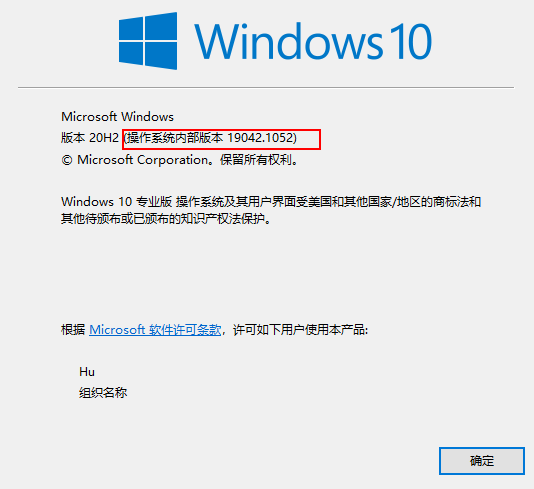
搜索启用或关闭windows功能
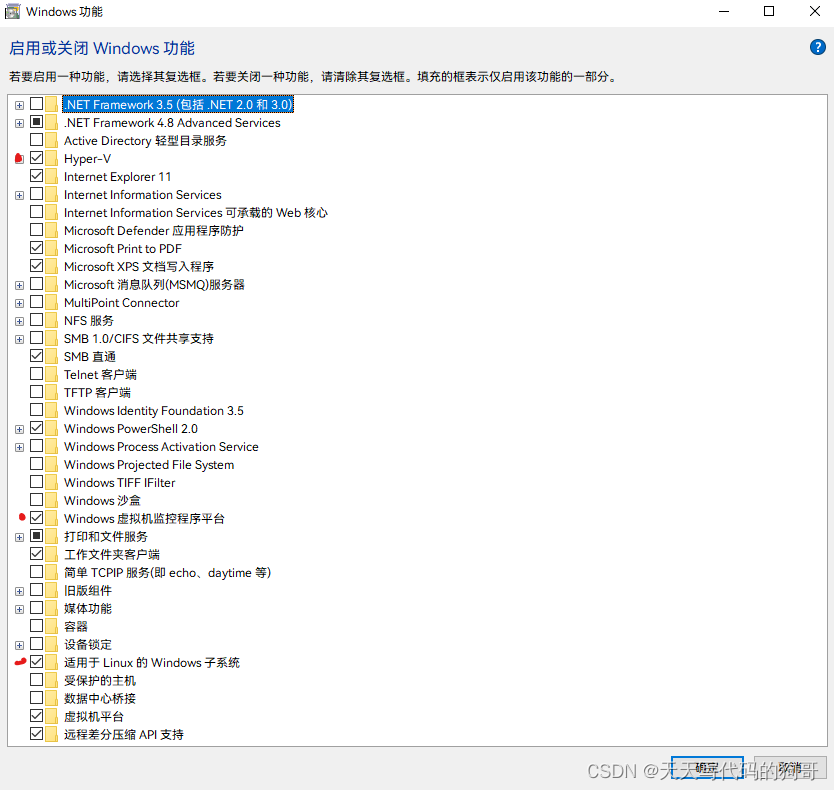
把图片中红点标注的功能勾选,注意勾选hyper-v就不能使用虚拟机类软件,如vm,安卓模拟器一类,点击确定,重启电脑。
打开任务管理器
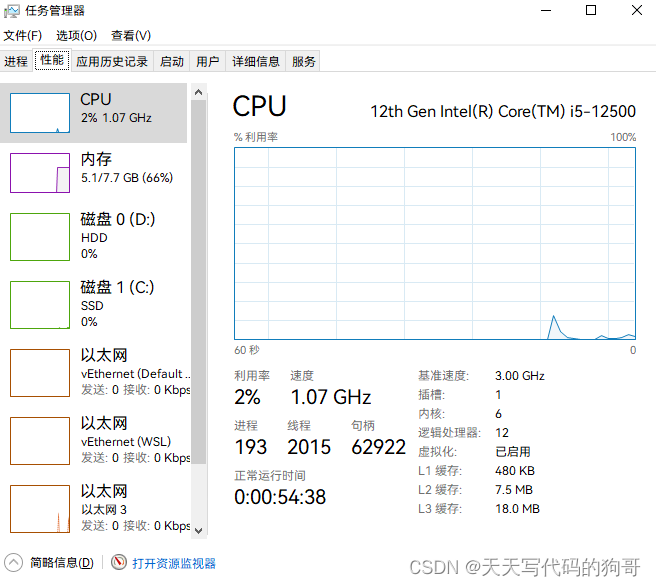
确保虚拟化已经启用,部分设备可能需要去bios设置,自行查阅下相关资料
下载64位wsl2内核升级包 https%3A//wslstorestorage.blob.core.windows.net/wslblob/wsl_update_x64.msi
安装后,设置默认wsl版本
wsl --set-default-version 2安装linux系统
方法一:可以从微软商店搜索安装,有概率会失败
方法二: 翻到页面最下方,下载你需要的版本 旧版 WSL 的手动安装步骤 | Microsoft Learn在旧版 Windows 上手动(而不是使用 wsl 安装命令)安装 WSL 的分步说明。 https://docs.microsoft.com/zh-cn/windows/wsl/install-manual给下载到的文件添加一个.zip后缀,用解压缩软件解压到你想安装的地方
https://docs.microsoft.com/zh-cn/windows/wsl/install-manual给下载到的文件添加一个.zip后缀,用解压缩软件解压到你想安装的地方
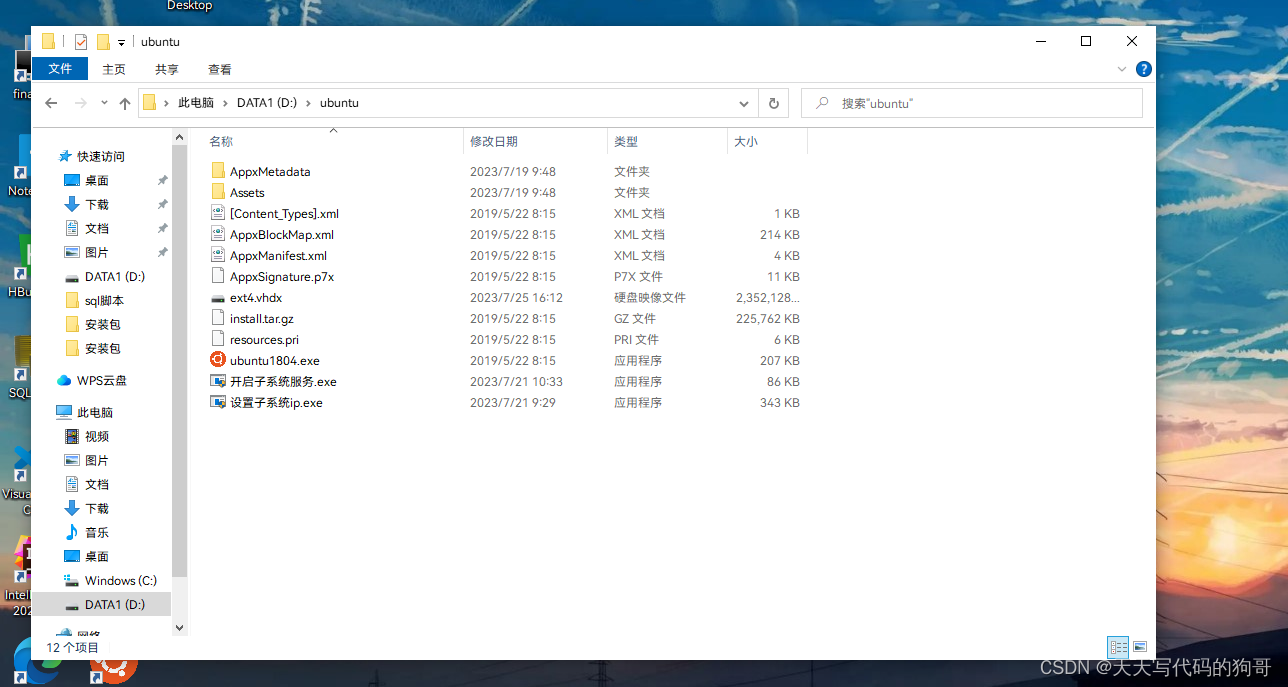
点击里面的ubnutu.exe文件,等待一会就会安装成功
去cmd中输入 wsl -l -v 查看安装的子系统版本
2、安装完成后的设置:
安装完成后会设置自己的用户名,密码(注意不是root账户)
设置root密码
sudo passwd切换root用户测试
su root每次切换root用户很麻烦,可以用powershell执行下面这条命令,默认root用户登录,其中参数自己替换下
C:\Users\用户名\AppData\Local\Microsoft\WindowsApps\ubuntu版本.exe config --default-user root开启ssh服务
首先确保是root用户
vi /etc/ssh/sshd_config进入之后,修改如下配置,可以直接复制我的,(我修改的项加了注释)
#$OpenBSD: sshd_config,v 1.101 2017/03/14 07:19:07 djm Exp $# This is the sshd server system-wide configuration file. See# sshd_config(5) for more information.# This sshd was compiled with PATH=/usr/bin:/bin:/usr/sbin:/sbin# The strategy used for options in the default sshd_config shipped with# OpenSSH is to specify options with their default value where# possible, but leave them commented. Uncommented options override the# default value.Port 22 #22端口,ssh服务默认端口#AddressFamily anyListenAddress 0.0.0.0 #所有ip都可以联通#ListenAddress ::#HostKey /etc/ssh/ssh_host_rsa_key#HostKey /etc/ssh/ssh_host_ecdsa_key#HostKey /etc/ssh/ssh_host_ed25519_key# Ciphers and keying#RekeyLimit default none# Logging#SyslogFacility AUTH#LogLevel INFO# Authentication:#LoginGraceTime 2m#PermitRootLogin prohibit-password#StrictModes yes#MaxAuthTries 6#MaxSessions 10PermitRootLogin yes #把上面那行相同的注释掉,新加一行,允许root账户登录#PubkeyAuthentication yes# Expect .ssh/authorized_keys2 to be disregarded by default in future.#AuthorizedKeysFile.ssh/authorized_keys .ssh/authorized_keys2#AuthorizedPrincipalsFile none#AuthorizedKeysCommand none#AuthorizedKeysCommandUser nobody# For this to work you will also need host keys in /etc/ssh/ssh_known_hosts#HostbasedAuthentication no# Change to yes if you don't trust ~/.ssh/known_hosts for# HostbasedAuthentication#IgnoreUserKnownHosts no# Don't read the user's ~/.rhosts and ~/.shosts files#IgnoreRhosts yes# To disable tunneled clear text passwords, change to no here!PasswordAuthentication yes #允许使用密码登录#PermitEmptyPasswords no# Change to yes to enable challenge-response passwords (beware issues with# some PAM modules and threads)ChallengeResponseAuthentication no# Kerberos options#KerberosAuthentication no#KerberosOrLocalPasswd yes#KerberosTicketCleanup yes#KerberosGetAFSToken no# GSSAPI options#GSSAPIAuthentication no#GSSAPICleanupCredentials yes#GSSAPIStrictAcceptorCheck yes#GSSAPIKeyExchange no# Set this to 'yes' to enable PAM authentication, account processing,# and session processing. If this is enabled, PAM authentication will# be allowed through the ChallengeResponseAuthentication and# PasswordAuthentication. Depending on your PAM configuration,# PAM authentication via ChallengeResponseAuthentication may bypass# the setting of "PermitRootLogin without-password".# If you just want the PAM account and session checks to run without# PAM authentication, then enable this but set PasswordAuthentication# and ChallengeResponseAuthentication to 'no'.UsePAM yes#AllowAgentForwarding yes#AllowTcpForwarding yes#GatewayPorts noX11Forwarding yes#X11DisplayOffset 10#X11UseLocalhost yes#PermitTTY yesPrintMotd no#PrintLastLog yes#TCPKeepAlive yes#UseLogin no#PermitUserEnvironment no#Compression delayed#ClientAliveInterval 0#ClientAliveCountMax 3#UseDNS no#PidFile /var/run/sshd.pid#MaxStartups 10:30:100#PermitTunnel no#ChrootDirectory none#VersionAddendum none# no default banner path#Banner none# Allow client to pass locale environment variablesAcceptEnv LANG LC_*# override default of no subsystemsSubsystemsftp/usr/lib/openssh/sftp-server# Example of overriding settings on a per-user basis#Match User anoncvs#X11Forwarding no#AllowTcpForwarding no#PermitTTY no#ForceCommand cvs server重启ssh项目
sudo service ssh restart使用ssh工具测试链接
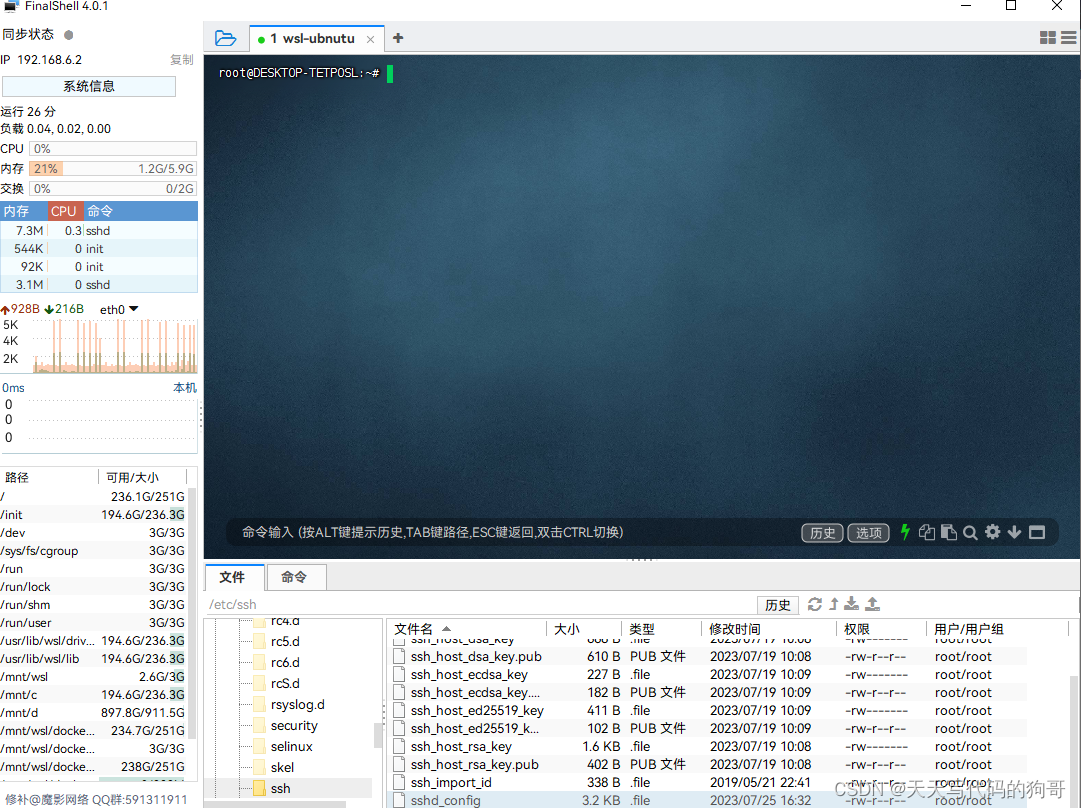
成功
3、windows下docker-desktop的安装
官网下载docker-desktop的安装包,一定要确保第一步开启的windows功能都开启了
Download Docker Desktop | Docker
正常软件安装流程
进入软件,点击小齿轮进入设置
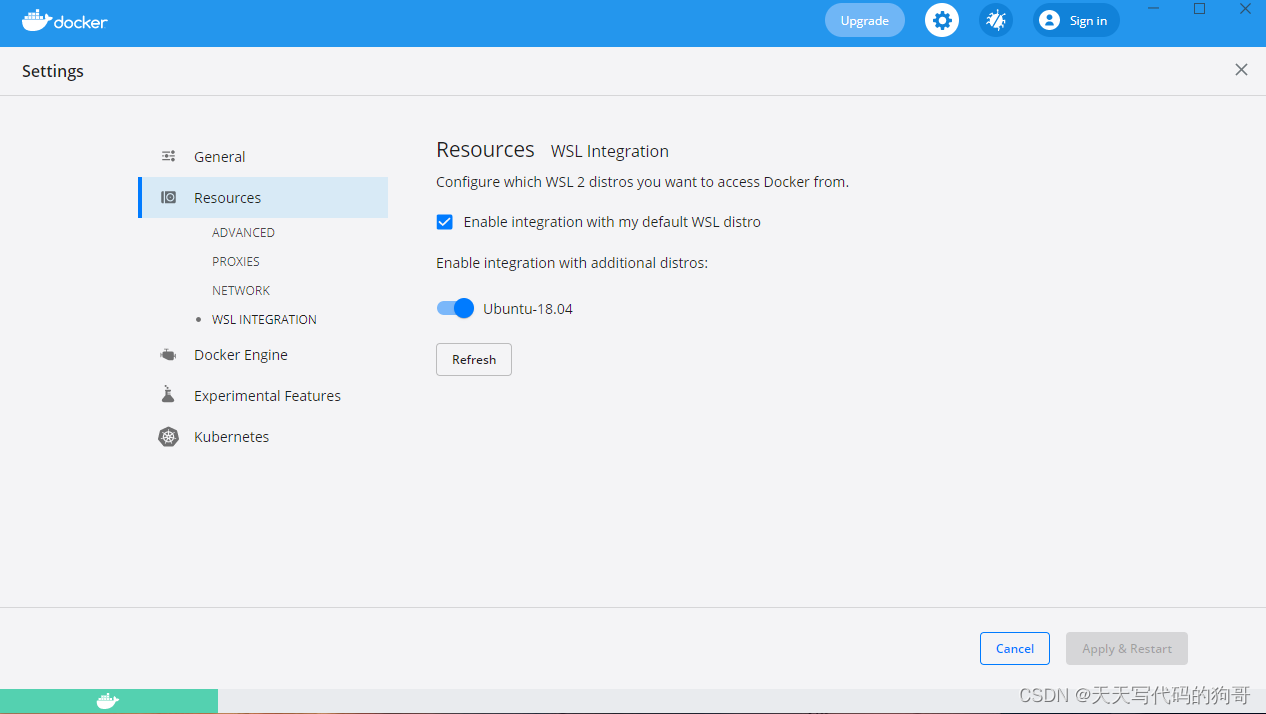
勾选你安装的ubnutu
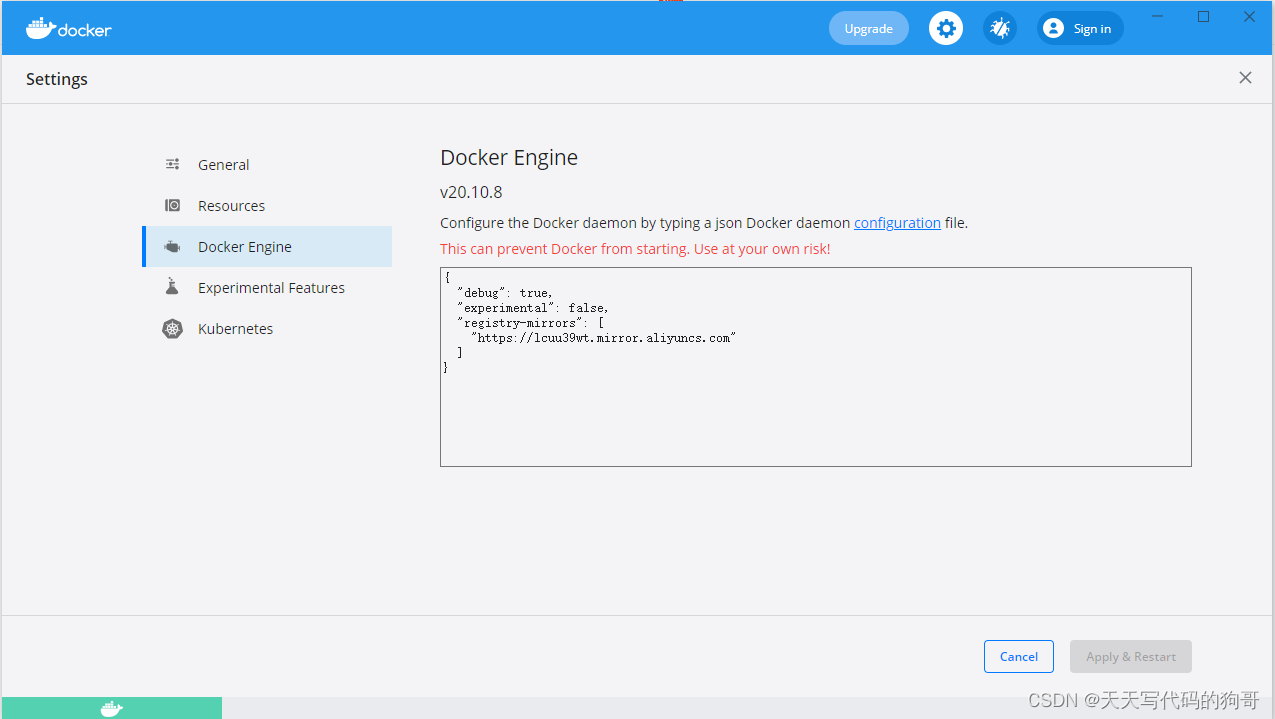
更改镜像仓库地址,我使用的阿里云,网上也有好多,比如中科大等
{ "debug": true, "experimental": false, "registry-mirrors": [ "https://lcuu39wt.mirror.aliyuncs.com" ]}resource中可以更改docker镜像位置,推荐更改,不然c盘会占用很高
设置完之后,打开终端,输入docker ps
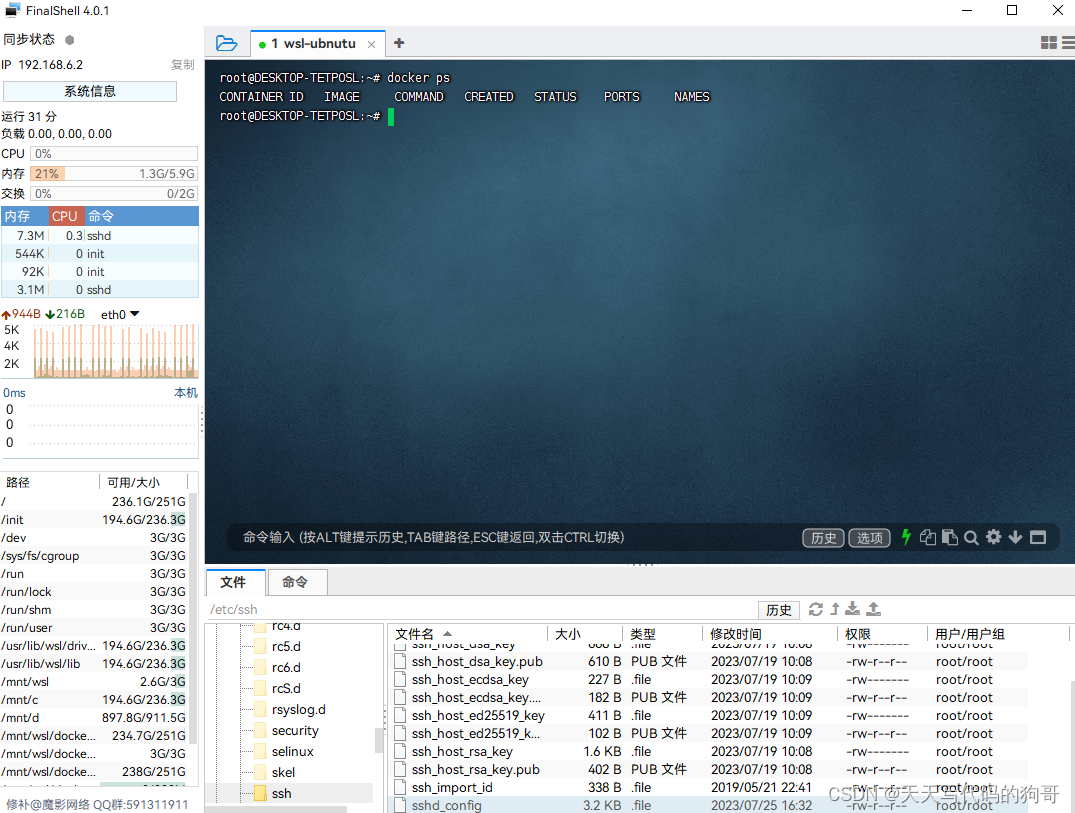
就会发现docker和你的linux子系统已经连接起来了
4、配置wsl2新特性,一定要开,否则会出现内存泄漏,爆内存的情况
C:\Users\电脑用户名文件夹下新建一个.wslconfig文件
# Settings apply across all Linux distros running on WSL 2[wsl2]# Limits VM memory to use no more than 4 GB, this can be set as whole numbers using GB or MBmemory=8GB# Sets the VM to use two virtual processorsprocessors=8[experimental]autoMemoryReclaim=gradual # 开启自动回收内存,可在 gradual, dropcache, disabled 之间选择networkingMode=mirrored # 开启镜像网络dnsTunneling=true # 开启 DNS Tunnelingfirewall=true # 开启 Windows 防火墙autoProxy=true # 开启自动同步代理sparseVhd=true # 开启自动释放 WSL2 虚拟硬盘空间重启wsl2或重启电脑生效
5、存在的问题及解决思路
ssh服务不会自动开启
解决思路:
重启ssh服务的命令,根据需要修改参数哦,可以写个cmd脚本放在windows自启动文件夹中,开机自己运行就不用每次输入了
C:\Users\用户名\AppData\Local\Microsoft\WindowsApps\ubuntu2004.exe run "sudo service ssh restart"